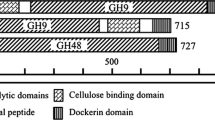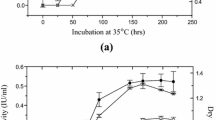Summary
A cellulolytic bacterium has been isolated from soil and identified as aCellulomonas sp. Optimization of media components and environmental factors led to a 17-fold increase in cellulase activity within 40 h. The trace elements Zn2+, Co2+ and Cu2+ caused severe inhibition, which could be reduced by the addition of EDTA. The enzymes endoglucanase, exoglucanase and xylanase were always present irrespective of the carbon source used.
Résumé
Une bactérie cellulolytique a été isolée à partir du sol et identifiée commeCellulomonas sp. L'activité cellulase en 40 h a été accrue 17 fois par optimisation des constituants du milieu et des conditions de culture. Des traces de Zn2+, Co2+, et Cu2+ déterminent une sévère inhibition, qui peut être réduite par l'addition d'EDTA. Les enzymes endoglucanase, exoglucanase et xylanase sont toujours présentes, quelque soit la source de carbone utilisée.
Resumen
Se ha aíslado e identificado comoCellulomonas sp. una bacteria cellulolítica del suelo. Mediante la optimización de los componentes del medio de crecimiento y de los factores ambientales se consiguió un incremento de 17 veces de la actividad cellulásica en 40 horas. Los elementos traza Zn2+, Co2+, y Cu2+ causaron una severa inhibición que pudo reducirse gracias a la adición de EDTA. Independientemente de la fuente de carbono utilizada los enzimas endoglucanasa, exoglucanasa y xilanasa se encontraron siempre presentes en el medio.
Similar content being viewed by others
References
Anon 1957Society of American Bacteriologists Manual of Microbiological Methods. pp. 315. New York: McGraw-Hill Book Co.
Anon 1983 ADAB-University of Queensland Microbial Culture Collection Training Course 1983 Practical Manual. Project 8: Purification of bacterial DNA and determination of mol% (G+C) by thermal denaturation. pp. 63–73. Australia: Department of Microbiology, University of Queensland.
Cauchon, N. &Leduy, A. 1984 Effect of dilution on carboxymethylcellulase and xylanase assays.Biotechnology and Bioengineering 26, 988–991.
Chiang, L. C. &Dunlap, C. E. 1977 A method using solubility to predict dry matter digestibility of cellulosic materials.Biotechnology and Bioengineering 19, 143–152.
Desai, J. D., Desai, A. J. &Patel, N. P. 1982 Production of cellulases and β-glucosidase by shake culture ofScytalidium lignicola.Journal of Fermentation Technology 60, 117–124.
Desrochers, M., Jurasek, L. & Koller, E. 1980 Production of cellulase in shake flask culture ofSchizophyllum commune: optimization of the medium. Technical Association of the Pulp and Paper Industry. 161–167.
Duong, T. V. C., Johnson, E. A. &Demain, A. L. 1983 Thermophilic, anaerobic and cellulolytic bacteria. InTopics in Enzyme and Fermentation Biotechnology ed. Wiseman, A. pp. 156–195. New York: John Wiley & Sons.
Galas, E., Pyc, R., Pyc, K. &Siwinska, K. 1981 Universal method for expressing activity of cellulolytic enzymes.European Journal of Applied Microbiology and Biotechnology 11, 229–233.
Garcia-Martinez, D. V., Shinmyo, A., Madia, A. &Demain, A. L. 1980 Studies on cellulase production byClostridium thermocellum.European Journal of Applied Microbiology and Biotechnology 9, 189–197.
Gilkes, N. R., Kilburn, D. G., Langford, M. L., Miller, R. C. Jr., Wakarchuk, W. W. Warren, R. A. J., Whittle, D. J. &Wong, W. K. R. 1984 Isolation and characterization ofEscherichia coli clones expressing cellulose genes fromCellulomonas fimi.Journal of General Microbiology 130, 1377–1384.
Gokhale, D. V., Soo-Han, E., Srinivasan, V. R. &Deobagkar, D. N. 1984 Transfer of DNA coding for cellulases fromCellulomonas sp. toBacillus subtilis by protoplast fusion.Biotechnology Letters 6, 627–632.
Haggett, K. D., Choi, W. Y. &Dunn, N. W. 1978 Mutants ofCellulomonas which produce increased levels of β-glucosidase.European Journal of Applied Microbiology and Biotechnology 6, 189–191.
Han, Y. W. &Srinivasan, V. R. 1968 Isolation and characterization of a cellulose-utilizing bacterium.Applied Microbiology 16, 1140–1145.
Hotten, P. M., Jones, K. L. &Grainger, J. M. 1983 The application of a mathematical model to an appraisal of the cellulose-azure method for determining cellulase activity.European Journal of Applied Microbiology and Biotechnology 18, 344–349.
Joglekar, A. V. &Karanth, N. G. 1984 Studies on cellulase production by a mutant—Penicillium fumiculosom UV-49.Biotechnology and Bioengineering 26, 1079–1084.
Kalunyants, K. A., Vagnova, M. D., Shchus, G. V., Chugunova, T. V. &Grachev, Yu. P. 1975 Optimization of the composition of the nutrient medium for cellulase biosynthesis by the fungusTrichoderma viride.Applied Biochemistry and Microbiology 12, 216–218.
Kalunyants, K. A., Feniksova, R. V., Baganova, M. S., Shchus, G. V. &Salovarova, V. P. 1976 Effect of different sources of nitrogen on cellulase biosynthesis during the submerged cultivation ofTrichoderma viride.Applied Biochemistry and Microbiology 12, 277–280.
Keddie, R. M. 1974 Genus III Cellulomonas, InBergey's Manual of Determinative Bacteriology 8th edn, ed. Buchanan, R. E. & Gibbons, N. E. pp. 629–631. Baltimore: Williams & Wilkins.
Klyosov, A. A. &Rabinowitch, M. L. 1980 Enzymatic conversion of cellulose to glucose: present state of the art and potential in enzyme engineering: Future directions, ed. Wingard, L. B. Jr., Berezin, I. V. & Klyosov, A. A., pp. 83–165. New York: Plenum Press.
Lee, S. B., Shin, H. S. &Ryu, D. D. Y. 1992 Adsorption of cellulase on cellulose: effect of physicochemical properties of cellulose on adsorption and rate of hydrolysis.Biotechnology and Bioengineering 24, 2137–2153.
Mandels, M. &Weber, J. 1969 The production of cellulases. InCellulases and their Applications, Advances in Chemistry Series 95, ed. Gould, R. F. pp. 391–414. Washington D.C.: American Chemical Society.
McDaniel, L. E., Bailey, E. G., Erhiraj, S. &Andrews, H. P. 1976 Application of response surface optimization techniques to polyene macrolide fermentation studies in shake flask.Developments in Industrial Microbiology 17, 91–94.
Nelson, N. 1944 A photometric adaptation of the Somogyi method for the determination of glucose.Journal of Biological Chemistry 153, 375–380.
Ostrikova, N. A. &Konovalov, S. A. 1983 Influence of nitrogen sources on cellulase biosynthesis by mutant strain.Applied Biochemistry and Microbiology 19, 339–450.
Panda, P., Bisaria, V. S. &Ghose, T. K. 1983 Studies on mixed fungal culture for cellulase and hemicellulase production. Part 1: optimization of medium for the mixed culture ofTrichoderma reesei D1-6 andAspergillus wentii Pt 2804.Biotechnology Letters 5, 767–772.
Salovarova, V. P., Grachev, Yu, P. &Vaganova, M. S. 1978 Influence of the composition of the nutrient medium on the biosynthesis of cellulolytic enzymes during submerged culturing of the fungusTrichoderma longibrachiatum 7–26.Applied Biochemistry and Microbiology 14, 140–142.
Shaker, H. M., Farid, M. A. &El-Diwany, A. I. 1984 Optimization of the composition of the medium for cellulase and protein synthesis by thermophilicAspergillus fumigatus NRC 272.Enzyme and Microbial Technology 6, 212–216.
Shewale, J. G. &Sadana, J. C. 1978 Cellulase and β-glucosidase production by a basidiomycete species.Canadian Journal of Microbiology 24, 1204–1216.
Skerman, V. B. D. 1968 A new type of micromanipulator and microforge.Journal of General Microbiology 54, 287–297.
Somogyi, M. 1952 Notes on sugar determination.Joural of Biological Chemistry 195, 19–23.
Stackebrandt, E. &Kandler, O. 1979 Taxonomy of the GenusCellulomonas, based on phenotypic characters and deoxyribonucleic acid—deoxyribonucleic acid homology, and proposed of seven neotype strains.International Journal of Systematic Bacteriology 29, 273–282.
Stewart, B. &Leatherwood, J. M. 1976 Derepressed synthesis of cellulase byCellulomonas.Journal of Bacteriology 128, 609–615.
Author information
Authors and Affiliations
Rights and permissions
About this article
Cite this article
Prasertsan, P., Doelle, H.W. Nutrient optimization for cellulase biosynthesis by a newly isolatedCellulomonas sp.. Mircen Journal 3, 33–43 (1987). https://doi.org/10.1007/BF01090493
Received:
Revised:
Accepted:
Issue Date:
DOI: https://doi.org/10.1007/BF01090493




